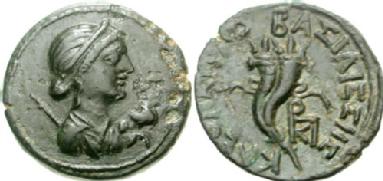All 1 entries tagged Cyprus
View all 2 entries tagged Cyprus on Warwick Blogs | View entries tagged Cyprus at Technorati | There are no images tagged Cyprus on this blog
September 01, 2013
A bronze coin struck in Cyprus showing Cleopatra VII and her young son Caesarion, 48–30 BC
Writing about web page Coin of the Month, November 2012
In 58 BC, Rome annexed Cyprus from Egypt.  Until then, the island had been an important part of the Ptolemaic Empire and had been ruled by the Ptolemies since c. 312 BC. From 58 BC, Cyprus was governed by Rome until Julius Caesar gifted the island to Cleopatra in c. 48-47 BC. The restoration of Ptolemaic power was also later confirmed by Marc Antony. As the final foreign stronghold to be confiscated from the Ptolemies, the annexation of Cyprus was a defining moment, contributing to the demise of the dynasty. The imagery depicted on this coin reflects the tactical decisions made by Cleopatra VII, the last ruling Ptolemy, who found herself trying to maintain power and authority over her lands during this period of political upheaval by aligning herself politically first with Julius Caesar, and then later with Marc Antony. On the front of the coin is an idealized portrait of Cleopatra as Aphrodite, the most important deity of Cyprus, whose sanctuary at Palaipaphos was famed in antiquity as the birthplace and home of the great goddess. On the coin, Cleopatra is also shown with her son by Julius Caesar, Caesarion, who is depicted as Eros in front of her. It is thought that the coin was issued to celebrate the birth of Caesarion. By appearing as Aphrodite and Eros, Cleopatra appears to be aligning herself with the ideology of the Caesars as being descended from Venus (Aphrodite's Roman counterpart) in order to secure a future for herself and her son, perhaps as Caesar's heir, in a very local context. With the suicides of Antony and Cleopatra following their defeat at the hands of Octavian at Alexandria, Cyprus along with Egypt fell under the control of Rome once and for all. The image of Aphrodite, represented as a sacred cone rather than in anthropomorphic form, remained an important symbol of Cyprus and was depicted on coinage minted in Cyprus under future Roman Emperors.
Until then, the island had been an important part of the Ptolemaic Empire and had been ruled by the Ptolemies since c. 312 BC. From 58 BC, Cyprus was governed by Rome until Julius Caesar gifted the island to Cleopatra in c. 48-47 BC. The restoration of Ptolemaic power was also later confirmed by Marc Antony. As the final foreign stronghold to be confiscated from the Ptolemies, the annexation of Cyprus was a defining moment, contributing to the demise of the dynasty. The imagery depicted on this coin reflects the tactical decisions made by Cleopatra VII, the last ruling Ptolemy, who found herself trying to maintain power and authority over her lands during this period of political upheaval by aligning herself politically first with Julius Caesar, and then later with Marc Antony. On the front of the coin is an idealized portrait of Cleopatra as Aphrodite, the most important deity of Cyprus, whose sanctuary at Palaipaphos was famed in antiquity as the birthplace and home of the great goddess. On the coin, Cleopatra is also shown with her son by Julius Caesar, Caesarion, who is depicted as Eros in front of her. It is thought that the coin was issued to celebrate the birth of Caesarion. By appearing as Aphrodite and Eros, Cleopatra appears to be aligning herself with the ideology of the Caesars as being descended from Venus (Aphrodite's Roman counterpart) in order to secure a future for herself and her son, perhaps as Caesar's heir, in a very local context. With the suicides of Antony and Cleopatra following their defeat at the hands of Octavian at Alexandria, Cyprus along with Egypt fell under the control of Rome once and for all. The image of Aphrodite, represented as a sacred cone rather than in anthropomorphic form, remained an important symbol of Cyprus and was depicted on coinage minted in Cyprus under future Roman Emperors.

This month's coin was chosen by Ersin Hussein, a PhD student in her final year of study. Ersin's PhD research focuses on the province of Roman Cyprus. Central to this study is the way in which the material record reflects the culture and society of Cyprus under Rome by demonstrating the adoption and assimilation of Roman practices while maintaining local, Cypriot customs.
(Coin image above reproduced courtesy of Classical Numismatic Group, Inc; http://www.cngcoins.com)
 Clare Rowan
Clare Rowan

 Please wait - comments are loading
Please wait - comments are loading

 Loading…
Loading…

